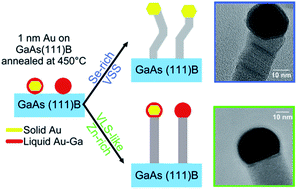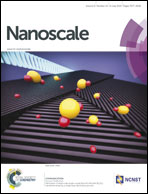Tuning the growth mode of nanowires via the interaction among seeds, substrates and beam fluxes†
Abstract
The growth mechanism of semiconductor nanowires is still an argument of high interest, and it is becoming clearer, investigation after investigation, that simple pictures fail to describe the complex behaviors observed under different growth conditions. We report here on the growth of semiconductor nanowires, maintaining control over the chemical composition and the physical state of the metallic seeds, and tuning the growth mechanism by varying the growth conditions. We focused on Au-assisted ZnSe nanowires grown by molecular beam epitaxy on GaAs(111)B substrates. We show that at sufficiently high temperatures, the Au seed is strongly affected by the interaction with the substrate and that nanowire growth can occur through two different mechanisms, which have a strong impact on the nanowire’s morphology and crystal quality. In particular, ZnSe NWs may exhibit either a uniformly oriented, straight morphology when the nanoparticle seed is liquid, or a kinked, worm-like shape when the nanoparticle seed is switched to a solid phase. This switch, which tunes the nanowire growth mechanism, is achieved by controlling the Zn-to-Se beam pressure ratio at the Au-seed surface. Our results allow a deeper understanding of particle-assisted nanowire growth, and an accurate control of nanowire morphology via the control of the growth mechanism.


 Please wait while we load your content...
Please wait while we load your content...